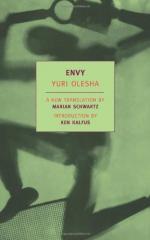|
This section contains 11,128 words (approx. 38 pages at 300 words per page) |

|
SOURCE: Michalski, Milena. “Cinematic Literature and Literary Cinema: Olesha, Room and the Search for a New Art Form.” In Russian Literature, Modernism and the Visual Arts, edited by Catriona Kelly and Stephen Lovell, pp. 220-49. Cambridge, England: Cambridge University Press, 2000.
In the following essay, Michalski examines cinematic techniques used in Olesha's literary works and analyzes Olesha's screenplay, Strogii iunosha, and its adaptation by filmmaker Abram Room.
Literature and Film: Iurii Olesha in Context
The 1920s and early 1930s in the Soviet Union was a period of experimentation and innovation in both literature and cinema. Writers felt that there should be a new Soviet literature, just as filmmakers felt that a new Soviet cinema was needed. The same general issues faced both arts: how to find a balance between elite and mass cultures, between ‘proletarian’ art and that of non-proletarian writers and filmmakers, whether or not writers and filmmakers...
|
This section contains 11,128 words (approx. 38 pages at 300 words per page) |

|


